History of textile art: Gunta Stölzl (1897-1983)
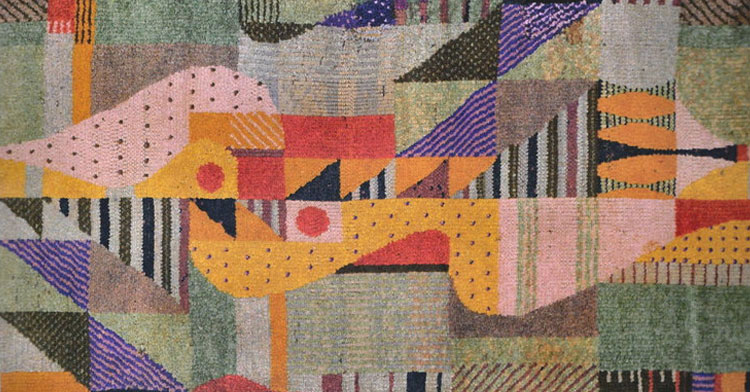
In the first of our history of textile art series, Martina Skender takes a look back at the extraordinary life and work of Gunta Stölzl.
Gunta Stölzl was a German textile artist who played a fundamental role in the development of the Bauhaus school’s weaving workshop. She created immense change within the textile field by uniting art practices taught at Bauhaus with traditional textile techniques and became the first woman Master at the school.
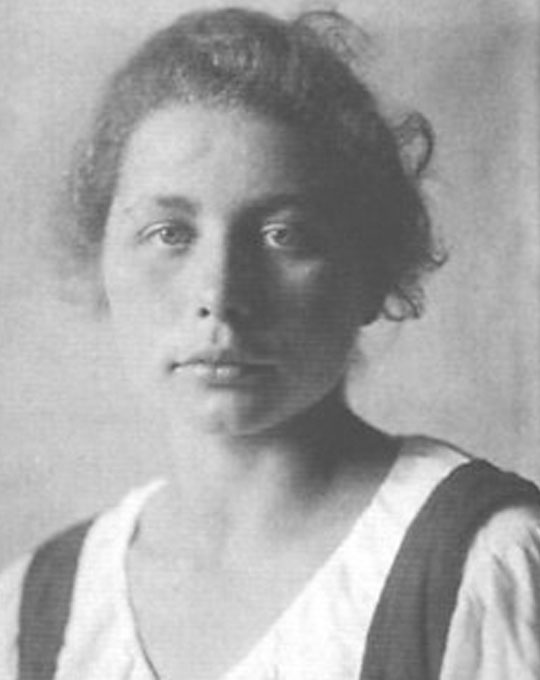
Gunta Stölzl, 1897-1983
The Bauhaus Manifesto
Upon her return home she went back to her studies at the School of Arts & Crafts, where she participated in the school’s curriculum reform. It was then that she found the Bauhaus Manifesto. Stölzl decided “why wait any longer at the Arts and Crafts School, for reforms to happen” when she could go to Bauhaus, where the reforms were already taking place (as described by her daughter, Monica, in a fascinating lecture that she gave at the Barbican Centre in London).
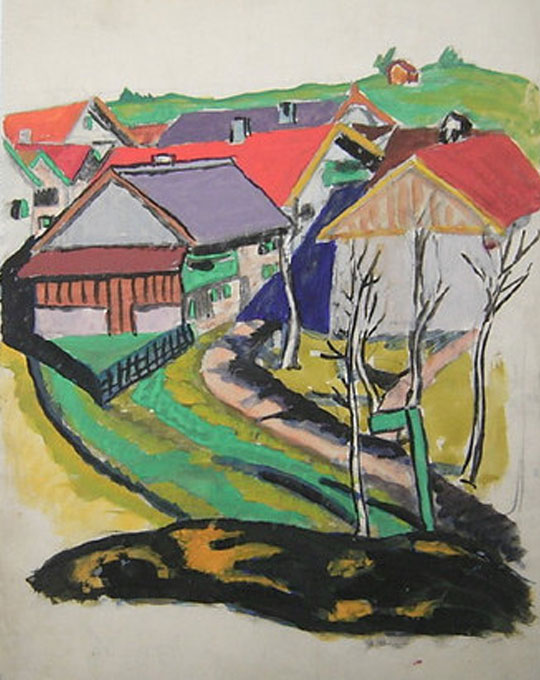
Gunta Stölzl, Untitled, 1915-1917
Image source: Gunta Stölzl Foundation
Bauhaus was a new school with new rules and new approaches to art and design through exploration of theory and practice. Bauhaus was also by definition “without regard to age or sex”. Gunta saw this opportunity and took part in creating what was at first called the Women’s department – which soon became the Weaving department.
Gunta Stölzl, Design for a runner, 12×4.8cm, 1923, Bauhaus-Archiv, Berlin
Image source: Gunta Stölzl Foundation
A new weaving practice
In her teaching Gunta applied ideas from modern art that she acquired in the classes of Jonannes Itten (color theory), Paul Klee (visual thinking) and Wassily Kandinsky (abstract art) into a new weaving practice. Bauhaus’ Weaving department at the time did not offer much for her to learn technically. Her and other students took courses and learned the craft outside of the school, soon becoming experts. Lack of technical guidelines allowed her and her colleagues to question and experiment with different materials and techniques, allowing them to make the step from traditional textile techniques and weaving done by generations before to the new weaving that would become admired by generations after.
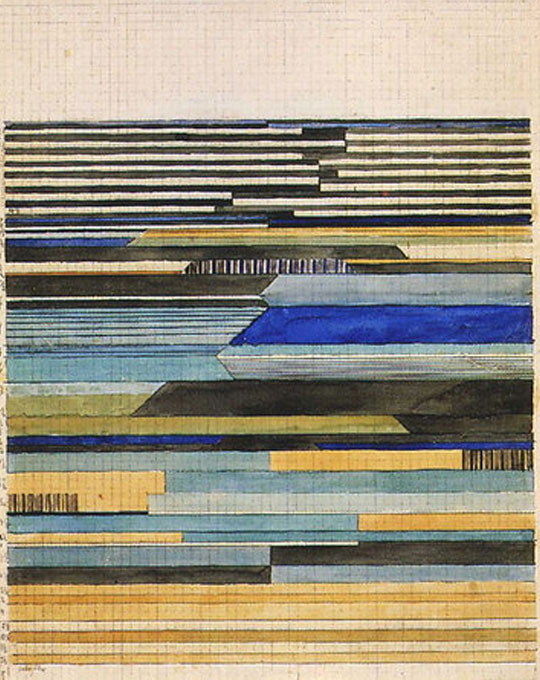
Gunta Stölzl, wall hanging, Mit gewendetem Schuetzen,1923
Image Source: Gunta Stölzl Foundation
Stölzl became the weaving Master in 1925 when Bauhaus relocated to Dessau. Weaving practices at the department soon became of a more functional nature following the needs of contemporary industrial design. Under her direction, Bauhaus Weaving Workshop became one of its most successful facilities.
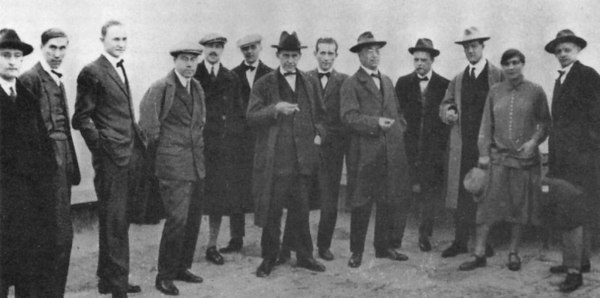
The Bauhaus masters on the roof of the new Bauhaus building, 1926 (Gunta is the only woman in the photograph) Photograph: Walter Gropius
Image Source: Gunta Stölzl Foundation
Personal life
In 1929 she married a Kibbutznik from Israel – Arieh Sharon, who later became a well known Israeli architect, and Gunta gave birth to a daughter named Yael. Because she married a Jewish man, Gunta’s German citizenship was taken away.
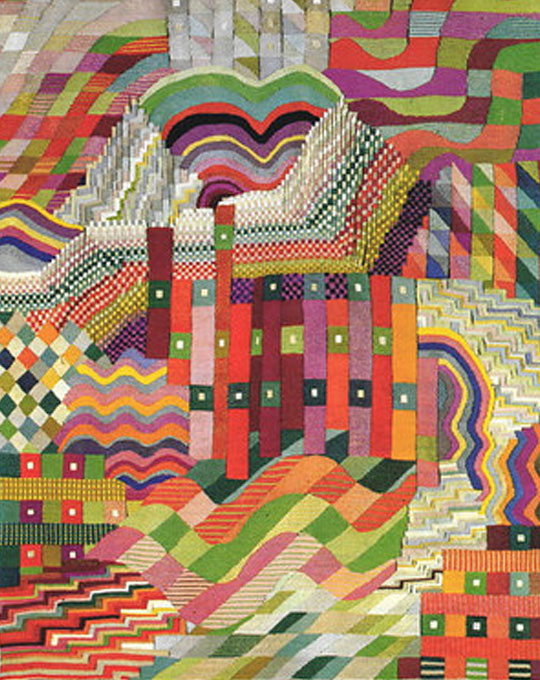
Gunta Stölzl, wall hanging, slit tapestry red/green,1927/28
Image source: Gunta Stölzl Foundation
In 1931 Gunta and Yael moved to Switzerland in order to avoid the rising tensions in Germany. From this point, her life and work were never as free and inspiring, or as fertile. Gunta continued to form textile companies with her students and later embarked on a solo project. In 1942 she married Willy Stadler and became a Swiss citizen. In 1943 she had a daughter – Monika. Monika describes the life they had: “There was little money, but we still went on vacations all the time”.
Later life and death
During the years 1987-1967 Gunta left her hand-weaving business and devoted herself to tapestry and weaving her own designs; she continued this practice until the end of her life. She died at age 86. At that time, her husband, feeling intimidated and frightened from reading Alma Mahler’s diaries, did not allow the opening of Gunta’s documents. Only after his death did Gunta’s daughters, Yael and Monika, review her documents and establish the G.S. Foundation.
Gunta had a rich life expressed in a comprehensive collection of her correspondence, her innovative and beautiful body of work. Textile art owes a lot to the first audacious threading movements established by Gunta. Her work is part of numerous museum collections in Europe, USA and Japan.
In 1968, looking back to her Bauhaus days, Gunta wrote “Even today, I believe that most important of all was life itself.”
Further reading:
- Bauhaus: Art as Life – Gunta Stolzl: A Daughter’s Perspective – lecture on Gunta’s life
- Gunta Stölzl Foundation – Extensive information about Gunta’s life and work
- Gunta Stölzl Foundation – List of articles and essays
- Bauhaus Online, Gunta Stölzl
- A history of textile art – The Art of Mankind by Mary Schoeser
If you’ve enjoyed this article, let us know which historical figure from the world of textiles you’d like to know more about by leaving a comment below
















extract from above article.
“Later life and death
During the years 1987-1967 Gunta left her hand-weaving business and devoted herself to tapestry and weaving her own designs; she continued this practice until the end of her life. She died at age 86. At that time, her husband, feeling intimidated and frightened from reading Alma Mahler’s diaries, did not allow the opening of Gunta’s documents. Only after his death did Gunta’s daughters, Yael and Monika, review her documents and establish the G.S. Foundation.”
the years written here don’t make sense. firstly they are the wrong way around, secondly, Gunta died in 1983 and so couldn’t have done anything between 1983 and 1987. so i am wondering what the dates should say.
LOVE IT, LOVE IT, LOVE IT
DONT MEAN TO SOUND LIKE YOU SET OFF THE PASSION IN ME BUT YOU DO
MORE!
I’d like to know if there are any letters, records or information about Otti Berger’s efforts and communication with Walter Gropius, or any other fellow Bauhaus artists, to get her visa in order to get to the U.S.